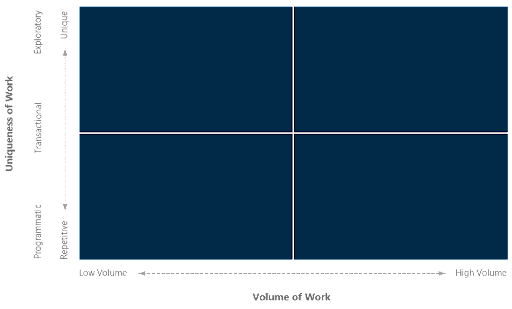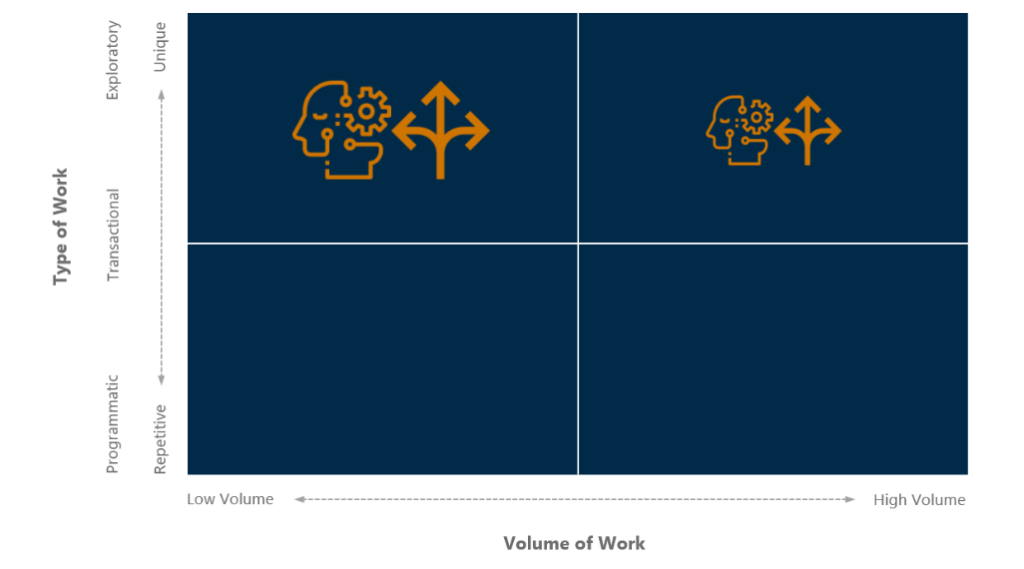
In Part 1 of this series on automation alignment, we described an overall approach to fitting the right type of automation to the type of work being
done. We discussed the high level of looking at the type of work being done and fitting Digital Business Automation (DBA) capabilities to that work.
Here in Part 2, we’ll focus on the Decision portion of DBA, indicated in Figure 1 in orange.
Figure 1: Digital Business Automation capabilities with Decisions highlighted

Decisions permeate our everyday lives. They are everywhere and happen minute by minute. Some of them are subconscious (taking the known
path to work), and some of them are highly conscious, such as deciding to seek out a new job. They also permeate the organizations where we work.
Every business has probably thousands of decisions made per day, with some of them being very opaque, others being driven by regulations, and
others just a part of the company’s culture. Whatever type they are, there is no question decisions are weaved into every thread of a business. The
question for us is, how can we best automate these decisions?
The way we approach making automation decisions is by leveraging an Automation Alignment Matrix (AAM). The Automation Alignment Matrix
allows us to analyze the type of work being done and map that to the type of automation recommended.
Figure 2: Automation Alignment Matrix

Along the Y-axis, we measure the Uniqueness of Work being done, while the Volume of Work is measured along the X-axis. What we are attempting
to do with this matrix is determine where an automation capability best fits into one of the four quadrants based on the type of work being done,
with the type of work determined by its uniqueness and volume. There are other factors an organization should take into account, such as assessing
the relationship between job performance and strategic value, which will help you determine the return on improved performance (ROIP). ROIP is
a subject unto its own, which we may cover in another blog. For a deeper dive into ROIP, read Part 1 -> Step 2 of Reinventing Jobs by Ravin Jesuthasan and John Boudreau.
Before we go too much further, some definitions seem appropriate. Low and High Volume (X-Axis), as well as Repetitive and Unique (Y-Axis), are
self-explanatory. However, the Programmatic, Transactional, and Exploratory terms along the X-Axis are less self-explanatory. The definitions for
Programmatic, Transactional, and Exploratory are from the MWD Advisor’s article mentioned earlier. These criteria were added to the X-Axis because
we felt they added more depth to the matrix. Below are definitions for the three words needing more explanation (somewhat appropriately, the
definitions for each of these get longer the less prescriptively the work can be defined up front):
We’ll look at Decision Automation in the context of all three types of work.
For programmatic work (highly predictable), the consideration comes down to whether it is worth it to automate these decisions by encapsulating
the logic in rules, typically via a decision management engine. Also, companies can consider whether the thousands of rules they have buried in code
should be externalized. These rules are what end up making many decisions for the company. However, they are not easy to get to or change, nor is
the logic transparent to the business users. For programmatic work, much of the decision of whether to leverage Decision Management to automate
the rules comes down to whether transparency, reuse, and ease of understanding are important for that set of rules. If any of these are true, then
Decision Management becomes a good choice for automating rules for programmatic and repetitive work, regardless of whether the work is low or
high volume.
Figure 3: Decision Automation for Programmatic Work

For Transactional work, because many of the tasks and decisions involved can be prescribed and designed in advance, much of the way decisions can
be automated here mirrors what we defined for programmatic work. However, because transactional work requires human discretion to carry out some
tasks, as well as deciding when, how and where work needs to progress, there is a wrinkle to the way Decision Automation should be applied to
Transactional work. For the highly predictable decisions, the standard approach of using prescribed business rules with predefined results is the best fit.
However, there are many situations in transactional work where things aren’t so predictable. In these cases, guided decisions are more appropriate than
prescriptive decisions. This allows the human to get advice based on predictive statistical models; this will help the human to take the next best step.
An example of this type of transactional work is a sales process where there are certain steps and rules which are always followed. However, there may
be certain points in the sales process where based on the current prospect data combined with historical data of other customers, the predictive engine
could recommend a few alternate actions which have produced the desired outcome (a sale, or even faster deal progression) in the past. Figure 3 indicates
Decisions are relevant in the Transactional part of the matrix for both low and high volume work.

Exploratory work is, by definition, unpredictable. The very word explore brings to mind going off and doing exciting and unforeseeable things. Every company
has a ton of exploratory work. This work is typically the highest value work done at a company. This area houses your knowledge workers, and we predict this
is where automation will eventually drive all human workers to live. Applying prescribed automation to exploratory work becomes much more difficult than
the other types of work, if not impossible. Think about the work your executive teams typically do. Mostly, it is making decisions and delegating work based on
their experience and knowledge of the business. Trying to predict those decisions and actions through prescribed rules and workflows would be a recipe for disaster.
Thus, prescriptive rules do not play much of a part here. However, guided decisions via AI engines suggesting next best actions are highly relevant here. If your
organization has a lot of historical data relevant to the exploratory area decisions are being made in, it would make sense to mine that data to determine what
decisions produced the most desired outcomes for your organization. From this, models could be created, which would augment knowledge workers to help
them make the best decisions. A great example of this is the way Ray Dalio described how his business ran in Principles: Life and Work. No decisions were made
without data, and because of this, their decisions kept getting better and better.
Figure 4: Decision Automation for Exploratory Work
 You may notice that the High Volume / Unique / Exploratory quadrant has an AI / Decisions icon which is smaller than the Low Volume / Unique / Exploratory quadrant.
You may notice that the High Volume / Unique / Exploratory quadrant has an AI / Decisions icon which is smaller than the Low Volume / Unique / Exploratory quadrant.
That is due to the nature of exploratory / unique work. There just isn’t a lot of work that is highly exploratory in nature and also high volume.
You now have a high–level approach to what type of work fits bests with what type of Decision Automation. In future blogs, we’ll cover Tasks, Workflow, Content, and
Data Capture, although not necessarily in that order.